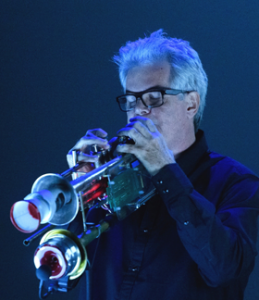- About Ramapo
- Academics
- Admissions & Aid
- Student Life
- Athletics
- Alumni
- Arts & Community
- Quick Links
- Apply
- Visit
- Give
Instructional Design Center
Faculty Profile: Ben Neill

Professor Ben Neill has had a distinguished career as an educator, performer, composer, and even inventor. With an interest in electronic music from early in his musical life, Professor Neill collaborated with Robert Moog, inventor of the first music synthesizer. The result was the Mutantrumpet, an electro-acoustic instrument that uses digital technology to enhance the sound and features of a traditional brass trumpet. Now in its fourth iteration, the Mutantrumpet has become an internationally recognized innovation in music technology. Video: Professor Ben Neill demonstrates his invention, the Mutantrumpet
Professor Neill is as exploratory in the classroom as he is with his music. When he first joined the Ramapo faculty in 2008, he began teaching the course Music Online for music majors and non-musicians alike. He discovered interactive online tools to help his students collaborate and improvise together. He also learned the virtue of patience when it comes to instructional technology. Professor Neill says, “Even though I have a lot of experience with technology, it still takes time to implement and troubleshoot. However, the results can definitely be worth it.”
Like all faculty members this semester, Professor Neill misses the opportunity to work with his students in person and the experience of interacting in a physical classroom. On the other hand, he recognizes some powerful opportunities with virtual learning. For example, he has noticed that students seem more comfortable expressing themselves in online discussion forums than raising their hand and volunteering in class. He also feels that he can get to know his students better through the personalized approach that he has developed for his virtual classes.
Since implementing Canvas in his courses last Spring, Professor Neill has harnessed the LMS in innovative ways, which other faculty can model. With Canvas Discussions, for instance, he creates a separate group for each student so that he can conduct private conversations with individuals about their work on a given topic or project. In this manner, the student treats the Discussion like a personal online journal, a dynamic tool for student expression and instructor feedback. He also employs the Peer Review tools in Canvas Assignments so that students can experience each other’s work and provide constructive feedback. Finally, Professor Neill is exploring the different apps that can be integrated into Canvas. He is particularly excited about FeedbackFruits, which enables instructors to embed discussion topics and reflection questions into videos, music, recorded lectures, and other media.
Professor Neill has some advice for successful implementation of the virtual classroom:
-
- Have a dedicated space. Create a space in your home that is ready to go for virtual instruction. That way you are always set up with your background, connections, and settings.
- Mix it up. Vary the kinds of activities and resources that you employ each week in a virtual class. This keeps students engaged and constantly exploring new ways of learning and communicating.
- Gamify your class. Look for resources that enable students to become more active in the learning experience. Our students are very immersed in digital technologies; if we can find ways to help them grow through technology, they will become better learners.
We look forward to learning more from Profesor Neill as he explores the realms of technology in his music and teaching.
Categories: Uncategorized
Copyright ©2025 Ramapo College Of New Jersey. Statements And Policies. Contact Webmaster.
